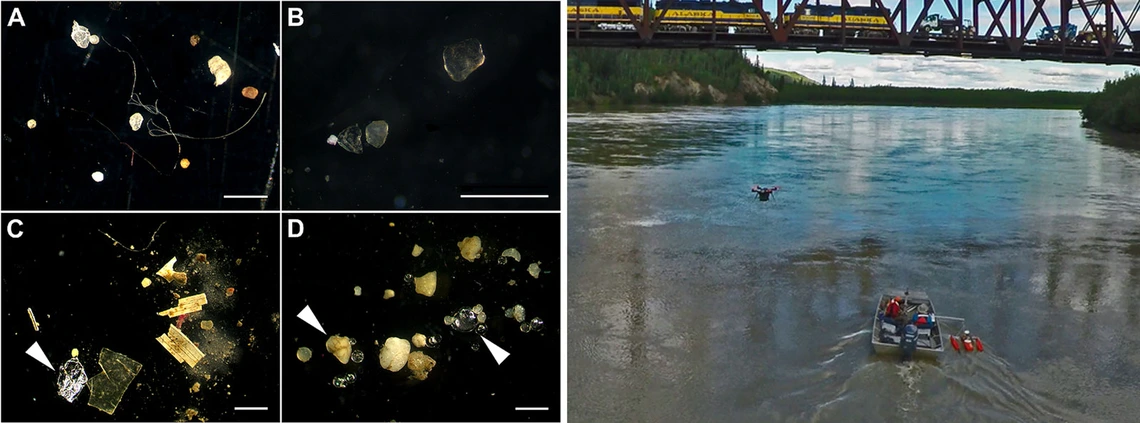
When
Where
Speaker(s)
On Wednesday, November 10, the WRRC hosted a Brown Bag webinar featuring presentations by student researchers who received funding in 2020 through the WRRC from the Water Resources Research Act, Section 104(b) grant program. Sarah E. Abney, PhD candidate in the UArizona Department of Environmental Science, shared her research on environmental microplastic contamination and the development of a filtering method to remove microplastics from our water supply. Abney shared fascinating information about the problem that microplastics pose: contamination of not only oceans and rivers, but also tap water. Microplastics come from not just plastic waste, but everything from clothes to cosmetics. Abney explained the process by which microplastics enter water systems and the food chain, ultimately ending up in humans. She discussed current methods for filtering wastewater to prepare it for human consumption and highlighted different methods of analyzing microplastics in water and their pitfalls. The result of Abney’s research is a new method of filtering out microplastics, which is low-cost and can filter high volumes of water.
Ammon F. Cadogan, who received his MS in Civil Engineering from UArizona, presented his research on the use of drones, or small unmanned aerial systems (sUAS), to remotely measure flow discharge after floods in dangerous areas. Flood events are the most common natural disaster and understanding the maximum amount of water that could flow through a given channel in a flood event is crucial for mitigation planning. Cadogan explained how drones can be used to measure the velocity of the water on the surface, and then use that to determine the velocity of water throughout the channel. Cadogan seeds the water by blowing rice cereal onto the water's surface, using the drone flying above to film the movement. He can then use that video and complex calculations to determine the flow rate. Cadogan’s research shows that drones can be reliably used to measure flood flow discharge.
Method Optimization for Reduction Analysis of Microplastics in Wastewater
Contamination of our environment from microplastics (1 mm to 5 mm in size) is gaining significant public interest due largely to their emergence as an environmental and potential human health threat. Microplastics have been detected in surface waters and treated wastewater effluents. The goal of this study is to provide the first low-cost, high-volume microplastic filtering method and information on mass balance of microplastics in wastewater treatment plants to inform reduction potential using Soil Aquifer Treatment. This study was conducted at the Water & Energy Sustainable Technology (WEST) Center in collaboration with the Pima County Reclamation Department who have recently acquired a Fourier Transformed Infrared Spectroscopic imaging system to identify and quantify types of microplastics. This instrument and its associated software provide information on the relative removal of different types of plastics (shape, size, and composition).
 Sarah E. Abney is a 3rd year PhD candidate at the UArizona College of Agriculture and Life Sciences in the Department of Environmental Science and is under the advisorship of Dr. Charles Gerba and Dr. Kelly Reynolds. She is a 2nd year Indige-FEWSS research trainee and contributes her time to advancing projects with her cohort on Indigenous Food-Energy-Water community engagement. Her research focuses include water quality management, water microbiology, and water virology - specifically in drinking waters, irrigation waters, and treated wastewaters. The overarching goal is to serve at the nexus of water-management, public health, and policy.
Sarah E. Abney is a 3rd year PhD candidate at the UArizona College of Agriculture and Life Sciences in the Department of Environmental Science and is under the advisorship of Dr. Charles Gerba and Dr. Kelly Reynolds. She is a 2nd year Indige-FEWSS research trainee and contributes her time to advancing projects with her cohort on Indigenous Food-Energy-Water community engagement. Her research focuses include water quality management, water microbiology, and water virology - specifically in drinking waters, irrigation waters, and treated wastewaters. The overarching goal is to serve at the nexus of water-management, public health, and policy.
Measuring River Discharge with Drones
The accurate measurement of river discharge during flooding events has long been a challenging and dangerous task in the Southwestern US where flows are often flashy and have a high sediment concentration. Small unmanned aerial systems (sUAS) can be deployed to access unsafe field sites and capture flow measurements remotely. Using the footage collected with the sUAS along with Large Scale Image Velocimetry techniques, a detailed surface velocity distribution can be obtained. Therefore, the use of sUAS for obtaining flow discharge measurements has become increasingly common in recent years. This research aims to improve the estimation of the velocity index by incorporating turbulence properties (e.g., energy dissipation rate) measured at the surface, channel roughness, and channel geometric properties. While limited in scope, this research shows that under ideal seeding and flow conditions, discharge can be calculated from surface flow velocities using the velocity index estimates from the turbulence dissipation rate method.
 Ammon obtained his undergraduate degree in Environmental Hydrology and graduate degree in Civil Engineering from the UArizona. While attending school, he worked at the US Geological Survey estimating water use across Arizona. He currently works at Craftwater Engineering in San Diego, California where he helps clients route rainwater into the ground instead of the ocean.
Ammon obtained his undergraduate degree in Environmental Hydrology and graduate degree in Civil Engineering from the UArizona. While attending school, he worked at the US Geological Survey estimating water use across Arizona. He currently works at Craftwater Engineering in San Diego, California where he helps clients route rainwater into the ground instead of the ocean.
Banner Image: Microplastics: Wikimedia Commons CC BY 4.0. Drone Image: USGS

